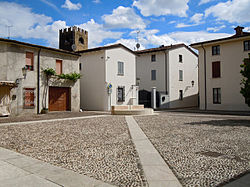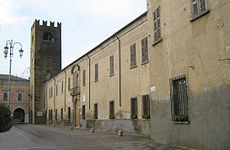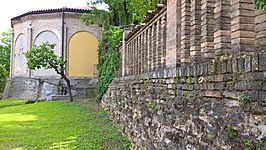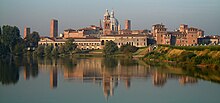| Itinerary of the center of Castel Goffredo (Castel Goffredo) | |
 | |
| Itinerary type | Pedestrian |
|---|---|
| State | Italy |
| Region | Lombardy |
| Territory | Alto Mantovano |
| City | Castel Goffredo |
Itinerary of the center of Castel Goffredo is an itinerary that takes place through the Old Town of Castel Goffredo, in province of Mantua, Lombardy.
Introduction
This itinerary, preferably performed on foot, follows the route of the city-fortress, ancient capital of the Gonzaga of Castel Goffredo and allows you to see the main monuments of the city.
When to go
| Climate | gen | Feb | mar | apr | mag | down | Jul | needle | set | Oct | nov | dec |
|---|---|---|---|---|---|---|---|---|---|---|---|---|
| Maximum (° C) | 4 | 8 | 13 | 17 | 22 | 26 | 29 | 28 | 24 | 18 | 10 | 5 |
| Minimum (° C) | -3 | -1 | 3 | 7 | 11 | 15 | 18 | 17 | 14 | 9 | 3 | -2 |
| Precipitation (mm) | 60 | 54 | 64 | 69 | 92 | 75 | 73 | 85 | 62 | 84 | 74 | 54 |
Source: Eurometeo | ||||||||||||
Preferably spring and in September-October. Continental climate with sultry summer, foggy late autumn and harsh winter.
Positive effects have the morainic hills which, very often, manage to create a bit of coolness. Average annual rainfall amounts to 1,060 mm, on average distributed over 88 rainy days, with a relative minimum in winter, maximum peak in autumn and secondary maximum in spring for accumulations.
To know the forecast for Castel Goffredo you can consult the Lombard Weather Center.
How to get

By plane
The nearest airports are:
 Bergamo-Orio al Serio Airport
Bergamo-Orio al Serio Airport Brescia-Montichiari Airport. Charter only.
Brescia-Montichiari Airport. Charter only. Verona-Villafranca Airport
Verona-Villafranca Airport
On the train
The nearest stations are:
 Desenzano del Garda railway station. Served by Frecciabianca for Milano Centrale, Torino Porta Susa, Trieste Centrale and Venezia Santa Lucia; from Frecciarossa to Brescia and Roma Termini and from regional to Milano Centrale and Verona Porta Nuova.
Desenzano del Garda railway station. Served by Frecciabianca for Milano Centrale, Torino Porta Susa, Trieste Centrale and Venezia Santa Lucia; from Frecciarossa to Brescia and Roma Termini and from regional to Milano Centrale and Verona Porta Nuova. Mantua railway station. On the director Verona-Modena.
Mantua railway station. On the director Verona-Modena. Asola station. On the director Brescia-Parma.
Asola station. On the director Brescia-Parma.

By car
The closest motorway exits are:
 Serenissima motorway: exit Desenzano del Garda, then direction Castiglione delle Stiviere.
Serenissima motorway: exit Desenzano del Garda, then direction Castiglione delle Stiviere. Brenner motorway: exit Mantua north, then direction Brescia. Guide it, Castiglione delle Stiviere.
Brenner motorway: exit Mantua north, then direction Brescia. Guide it, Castiglione delle Stiviere. Highway: exit Cremona, then direction Mantua.
Highway: exit Cremona, then direction Mantua.
By bus
 Service carried out by APAM.
Service carried out by APAM.
Parking lots
Free
 Martyrs of Liberation Square
Martyrs of Liberation Square Virgilio middle school square (free only on holidays)
Virgilio middle school square (free only on holidays) Square of the cemetery
Square of the cemetery
How to get around
The itinerary can be covered entirely on foot or even by bicycle.
Stages
From point 1 to point 5


The tour starts from 1 Porta Picaloca, the only remaining of the four doors of the sixteenth-century fortress (Porta di Sopra, Porta Poncarali, Porta di Sotto). 2 Old Hospital, founded in the fifteenth century. Before reaching the central square, on the right you will find the 3 Jewish quarter and the ancient Synagogue, of which unfortunately no traces remain today. On via Mantova, on the left side of the provost church, there are some 4 Gonzaga epigraphs of the sixteenth century, dating back to the time of Aloisio Gonzaga, Marquis of Castel Goffredo, once located on the Church of Santa Maria del Consorzio. In a recess on the left, near Piazza Mazzini, is the 5 Monument to don Aldo Moratti, a curate who dedicated his life to children, the suffering and the needy.
From point 6 to point 13
After a few steps, you enter the scenography 6 Mazzini square, the heart of the city, where the main historical buildings are located: the 7 Torrazzo with the 8 Gonzaga-Acerbi Palace, which has always been the seat of the lords of Castel Goffredo; the fourteenth century 9 Civic tower, symbol of the city, the 10 Town Hall and Loggia of the Magnificent Community, the 11 Riva Palace, i 12 Sixteenth-century arcades with the shops of the merchants; There is a fountain in white marble that was used for drinking until the nineteenth century. Closes the square, the 13 Provost Church of Sant'Erasmo with the Treasure of Sant'Erasmo.

Gonzaga-Acerbi Palace
Municipal building

Civic tower
Church of Sant'Erasmo
From point 14 to point 16

Flanking the church, take via Andrea Botturi, politician Castellano and meets the 14 MAST Castel Goffredo, city museum, located in the Palazzo della Prevostura. In front, the 15 Church of San Giuseppe, in Baroque style, originally used as a stable of the Gonzaga. To follow the 16 Negri Palace, seat of the Provost of Castel Goffredo.
From point 17 to point 19

Continue to the end of via Botturi where the 17 Porta di Sotto, flanked by the ancient walls. Take Via Piave on the right, follow it to the end to reach the sixteenth century 18 Church of the Disciplini. Behind the apse of the church, on the left, on a white residential house, was the 19 Tower of the Disciplini, one of the seven towers defending the fortress-city.
From point 20 to point 22
Go along via Montello to take via Poncarali on the right, then along via Italia you reach the 20 La Fontanella Park, inside which is located the 21 Tower of Sant'Antonio, one of the seven defending the walled city, on which a roundabout used as a summer bar has been rebuilt. On the left of the tower, an ancient stretch of 22 Gonzaga walls from the 15th century (towards the Fuga stream).

La Fontanella Park and S. Antonio Tower

Gonzaga walls
From point 23 to point 26


Once out of the park, from Piazza Martiri della Liberazione you reach, by turning right, the 23 Castelvecchio square, the oldest in the city, in the center of the ancient village of 24 Castelvecchio, the first nucleus of the fortified city. Embarked 25 Vicolo Carlo V, which recalls the visit of the emperor in 1543 to the town, is flanked by the former 26 Church of Santa Maria del Consorzio, originally the oldest in the village and refounded in the fifteenth century.
From point 27 to point 28
Via Manzoni, at the end of which it was located 27 Porta di Sopra with the rivellino and the defense moat, go along a stretch of via Monte Grappa, in the middle of which, on the right at street number n. 25, you can still see the 28 First walls with marble redondone.
Return
After a few meters, you enter 29 alley Cannone, still in the Castelvecchio village, at the end of which you return to the central Piazza Mazzini.
Safety
Around
Excursions
- Lake Garda - It is one of the great Lombard lakes; the eastern shore is Venetian, the tip to the north it is thirty. A destination for climatic tourism since the nineteenth century, every coastal town lives and develops with tourism. Main destinations are Sirmione, Desenzano del Garda, Salò, Riva del Garda, Garda, Peschiera del Garda.
- Mantua - A city rich in important art treasures, Mantua is universally known as the city of the Gonzagas, who for four centuries ruled it holding one of the most sumptuous courts in Europe and made it one of the most beautiful cities of the Renaissance. For the exceptional testimony of urban, architectural and artistic realization of the Renaissance, linked together through the ideas and ambitions of the ruling family, the Gonzagas, Mantua together with Sabbioneta, in 2008, they were declared by UNESCO World Heritage. Mantua was named the Italian Capital of Culture for 2016.
- Cremona - It has a monumental historic center - the Cathedral, the Baptistery, the Town Hall - one of the most distinguished in Lombardy. It was a Roman city. It was powerful at the time of the Communes and rivaled Milan, which finally subdued it. His violins (Stradivari and Amati), his Torrazzo and even more his torrone, are known everywhere.
- Casatico (Marcaria) - It is the homeland of the famous scholar Baldassarre Castiglione, who was born here on December 6, 1478. Interesting Corte Castiglioni, built in the fifteenth century and remodeled in the sixteenth and eighteenth centuries.

Itineraries
Castel Goffredo itineraries
- Rural churches and oratories of Castel Goffredo - The itinerary, entirely in the green countryside of Castel Goffredo rich in streams, it runs through the numerous places of worship, which boast ancient traditions and are the sign of a widespread religiosity, since the sixteenth century.
Other itineraries

- Places of the battle of Solferino and San Martino - The itinerary runs through the places where the historic one took place on 24 June 1859 battle of Solferino and San Martino.
- In the lands of the Gonzagas - An itinerary through the centers, large and small, which were the capitals of the Gonzaga cadet branches: principalities, marquisates, duchies which, within the Mantuan state structure, enjoyed real independence, often minted coins and held refined courts that rivaled that of Mantua, embellished their urban centers by equipping them with elegant architecture - churches, squares, palaces, walls, towers - and characteristic urban views such as the typical Gonzaga arcades.
- Morainic hills of Lake Garda - On the first corrugations of the Po plain that becomes a hill, where the great lake basin of the Lake Garda, the route touches towns and cities that were the domain of Gonzaga, Venice, Scaligero, and then became the scene of the bloody battles of the Risorgimento that were the prelude to the unification of Italy. To the tourist, historical and naturalistic importance the area combines an oenological interest as an area of production of wines from the hills, tokai, merlot and claret.







